Themed collection Sanitation

Pitfalls and progress: a perspective on achieving sustainable sanitation for all
This article provides a perspective on the reasons behind why we have not yet achieved sustainable sanitation for all, i.e. universal access to some form of improved toilet and sludge management services, and presents research needs and strategies for moving closer to this goal.
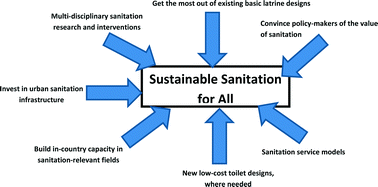
Environ. Sci.: Water Res. Technol., 2015,1, 17-21
https://doi.org/10.1039/C4EW00087K
A review of sanitation technologies to achieve multiple sustainable development goals that promote resource recovery
This study critically reviews literature and provides material flows of nitrogen, phosphorus, and carbon to determine the ability of existing sanitation technologies and strategies that can be deployed to safely recover resources and thus achieve multiple sustainable development goals.

Environ. Sci.: Water Res. Technol., 2018,4, 16-32
https://doi.org/10.1039/C7EW00195A
Development of trash exclusion for mechanized pit latrine emptying
The trash-excluding attachment (Excluder) can be connected to a custom vacuum (such as the Flexcrevator), a vacuum truck, or a sludge pump. The system allows the mechanized emptying of pit latrines with high levels of trash without manual “fishing”.
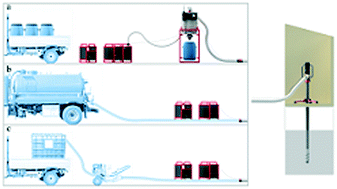
Environ. Sci.: Water Res. Technol., 2021,7, 1714-1722
https://doi.org/10.1039/D1EW00383F
Safe resource recovery from faecal sludge: evidence from an innovative treatment system in rural Tanzania
A novel treatment system for pit latrine faecal sludge; solar-dried sludge with captured leachate heat-treated in agriculture using waste-fired rocket stove.
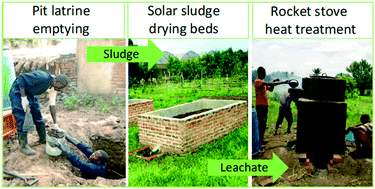
Environ. Sci.: Water Res. Technol., 2020,6, 1737-1748
https://doi.org/10.1039/C9EW01097A
Field testing of an onsite sanitation system on apartment building blackwater using biological treatment and electrochemical disinfection
Demonstration of an electrochemical toilet wastewater treatment and disinfection technology at the scale of an apartment building and translation of the system into a commercial product.

Environ. Sci.: Water Res. Technol., 2020,6, 1400-1411
https://doi.org/10.1039/C9EW01106D
Understanding fecal sludge drying in membrane-lined container-based toilets for developing countries with CFD modeling
CFD model evaluated toilet container lined with laminated hydrophobic membrane. Model predicted drying accurately for cm- to m-scale systems. Model predicted performance of laminate-lined toilet for developing countries.
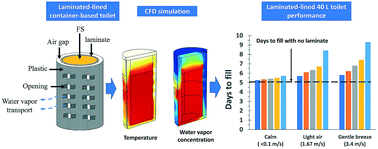
Environ. Sci.: Water Res. Technol., 2019,5, 2219-2231
https://doi.org/10.1039/C9EW00583H
Assessing the sustainability of on-site sanitation systems using multi-criteria analysis
Integrated approach to assess the sustainability of on-site sanitation systems.
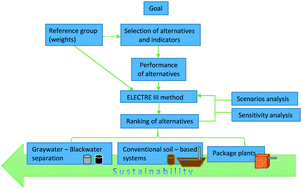
Environ. Sci.: Water Res. Technol., 2019,5, 1599-1615
https://doi.org/10.1039/C9EW00425D
Quantification of liquid phase faecal odourants to evaluate membrane technology for wastewater reuse from decentralised sanitation facilities
A liquid phase method to treat faecal odourants at source using membrane technology, consequently encouraging facility and water reuse acceptance.
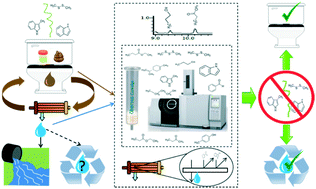
Environ. Sci.: Water Res. Technol., 2019,5, 161-171
https://doi.org/10.1039/C8EW00693H
A comparison of interviews, focus groups, and photovoice to identify sanitation priorities and increase success of community-based sanitation systems
Semi-structured interviews with females and community members identified the greatest number of unique and most priorities in resource-limited communities.
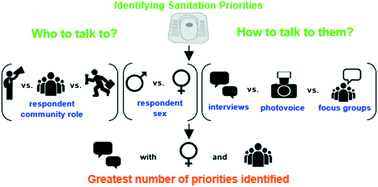
Environ. Sci.: Water Res. Technol., 2018,4, 1451-1463
https://doi.org/10.1039/C8EW00391B
Design and preliminary implementation of onsite electrochemical wastewater treatment and recycling toilets for the developing world
Self-contained toilet wastewater treatment system prototypes based on electrochemical oxidation of feces and urine using bi-layered semiconductor anodes ([Bi2O3]z[TiO2]1−z/IrxTayO2/Ti) have been designed, constructed, and implemented in regions where access to proper and sufficient sanitation is limited.
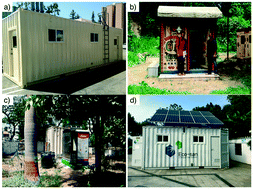
Environ. Sci.: Water Res. Technol., 2018,4, 1439-1450
https://doi.org/10.1039/C8EW00209F
The feasibility of char and bio-oil production from pyrolysis of pit latrine sludge
Energy recovery from bio-oil was feasible when pit latrine sludge with a water content of ≤∼55% was the feedstock.
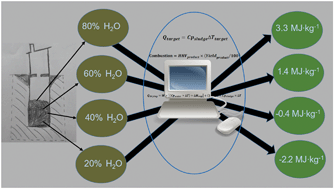
Environ. Sci.: Water Res. Technol., 2018,4, 253-264
https://doi.org/10.1039/C7EW00380C
Virus inactivation in stored human urine, sludge and animal manure under typical conditions of storage or mesophilic anaerobic digestion
Viruses represent major disease transmitting agents carried by human excreta and animal manure.
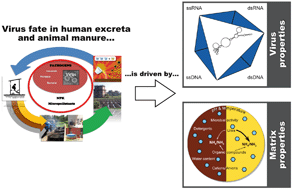
Environ. Sci.: Water Res. Technol., 2017,3, 492-501
https://doi.org/10.1039/C6EW00311G
How sociopolitical factors affected the implementation of Cape Town's vacuum sewer
This paper discusses various institutional and social conflicts that detrimentally affected the implementation of a vacuum sewer in South Africa.
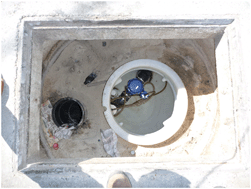
Environ. Sci.: Water Res. Technol., 2017,3, 513-519
https://doi.org/10.1039/C6EW00089D
Selection of screw characteristics and operational boundary conditions to facilitate post-flush urine and faeces separation within single household sanitation systems
This article demonstrates the application of a screw auger to separate fresh urine and faeces in a household scale sanitation system.
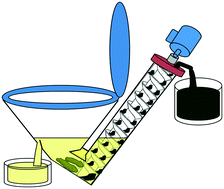
Environ. Sci.: Water Res. Technol., 2016,2, 953-964
https://doi.org/10.1039/C6EW00170J
Testing methods for new pit latrine designs in rural and peri-urban areas of Malawi where conventional testing is difficult to employ
There is a trend towards participation of users in the design of appropriate sanitation facilities for low-income countries.

Environ. Sci.: Water Res. Technol., 2016,2, 726-732
https://doi.org/10.1039/C5EW00246J
Achieving sustainable sanitation chains through better informed and more systematic improvements: lessons from multi-city research in Sub-Saharan Africa
Consolidating findings from research managed by 5 international consortia considering the factors that influence the development and effectiveness of sanitation service chains in 9 cities of Francophone and Anglophone Africa.

Environ. Sci.: Water Res. Technol., 2016,2, 492-501
https://doi.org/10.1039/C5EW00255A
Cost-effectiveness and community impacts of two urine-collection programs in rural South Africa
The cost-effectiveness of two different urine-collection programs in South Africa are modelled over a range of parameters and are interpreted from the perspective of both the municipality and the community.
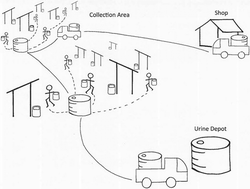
Environ. Sci.: Water Res. Technol., 2016,2, 320-335
https://doi.org/10.1039/C5EW00237K
Pee power urinal – microbial fuel cell technology field trials in the context of sanitation
This paper reports on the pee power urinal field trials, which are using microbial fuel cells for internal lighting.
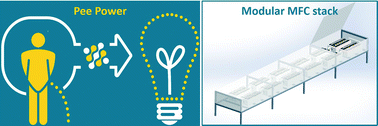
Environ. Sci.: Water Res. Technol., 2016,2, 336-343
https://doi.org/10.1039/C5EW00270B
Optimisation and costing of faecal sludge management options for Lusaka's informal settlements
This paper presents a methodology to support the implementation of Faecal Sludge Management services in informal settlements in Lusaka, The Republic of Zambia.

Environ. Sci.: Water Res. Technol., 2016,2, 97-106
https://doi.org/10.1039/C5EW00179J
About this collection
Guest Edited by Associate Editor Dr Michael Templeton (Imperial College London), this themed collection of Environmental Science: Water Research & Technology gathers a variety of manuscripts focused on sanitation research.
The collection seeks to showcase novel work on sanitation, covering topics such as onsite sanitation technologies, solutions for areas with high water tables, sanitation for emergency relief situations, faecal sludge properties and treatment, biogas recovery technologies at household scale, sanitation service models, simplified sewerage and drainage, urban sanitation challenges and large-scale sanitation solutions.
If you are currently doing research on sanitation and would like to contribute to this ongoing collection, please get in touch with us.